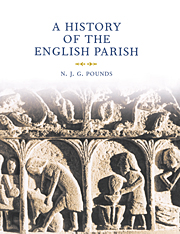Book contents
- Frontmatter
- Contents
- List of illustrations
- Preface
- List of abbreviations
- PART I THE ORIGINS OF THE PAROCHIAL SYSTEM
- PART II THE FUNCTIONS OF THE PARISH
- PART III THE PARISH AND ITS CHURCH
- 10 The parish: its church and churchyard
- 11 The fabric of the church: the priest's church
- 12 The peoples's church: the nave and the laity
- Notes
- Index
12 - The peoples's church: the nave and the laity
Published online by Cambridge University Press: 29 July 2009
- Frontmatter
- Contents
- List of illustrations
- Preface
- List of abbreviations
- PART I THE ORIGINS OF THE PAROCHIAL SYSTEM
- PART II THE FUNCTIONS OF THE PARISH
- PART III THE PARISH AND ITS CHURCH
- 10 The parish: its church and churchyard
- 11 The fabric of the church: the priest's church
- 12 The peoples's church: the nave and the laity
- Notes
- Index
Summary
The church, in the countryside at least, was the only tangible
manifestation of the community.
C. S. L. DaviesThe rood-screen did more than separate nave from chancel. It divided the laity from the priesthood, and the financial obligations of the one from those of the other. Its barrier nature was considerably reduced at the Reformation, and churches built during the later seventeenth and eighteenth centuries were generally conceived as large halls, without physical division between nave and chancel. But never in law or in practice did this division of the church cease to exist.
The nave was always the sphere of the parishioners. They alone were responsible for its building and upkeep, and they were free, within certain limits, to do what they wished with it. How they built it and kept it in at least a reasonable state of repair has been discussed elsewhere (pp. 395–7); we are here concerned rather with the uses to which the parishioners put their part of their own church.
THE NAVE: ITS SIZE AND PLAN
Almost without exception the nave with its aisles has always been the larger of the two major divisions of the parish church. It had to be so. Attendance on Sundays and on certain feasts was obligatory, and the nave had to be capable of accommodating at least the adult population of the parish, which might have run to two or three hundred persons. Before pews were introduced people had either to stand or to kneel.
- Type
- Chapter
- Information
- A History of the English ParishThe Culture of Religion from Augustine to Victoria, pp. 464 - 510Publisher: Cambridge University PressPrint publication year: 2000



